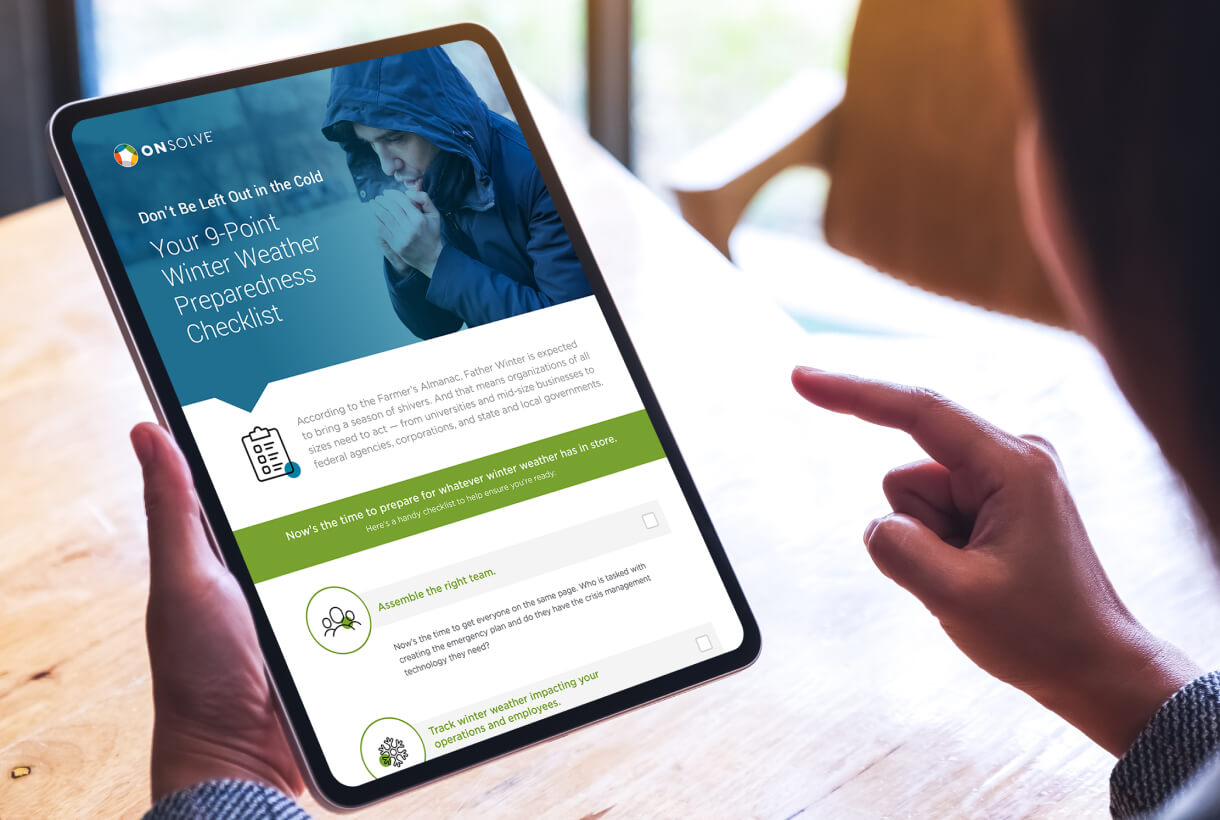When Halloween decorations show up in stores, you know winter’s right around the corner. While snow is beautiful, the ice and storms that accompany it make it challenging for organizations trying to keep employees safe and operations running.
It's likely this year's winter weather season will deliver a chill. The 2024 Old Farmer’s Almanac predicts most snow-prone areas will see snowfall at above-normal levels and "normal to colder-than-normal temperatures."
To weather this wild winter ride, organizations of all sizes — from universities and mid-size businesses to federal agencies, corporations, and state and local governments —need to take action now.
Hopefully, you’re getting ready to update your winter crisis communications plan, but you may be wondering if you’ve got all your bases covered. Here's a handy 9-point checklist to help reduce your winter weather stress:
Creating a Proactive Emergency Plan and Team
1. Assemble the right team. Who is tasked with creating the winter weather emergency plan? Most likely the security team, with emergency management professionals and safety teams. Be sure they’re outfitted with the latest technology. A platform that provides a unified, 360-degree view of critical event management (CEM) gives response teams a complete picture of what’s happening and how it may impact your business in real time. Armed with this information, they can make faster and smarter decisions for a quicker recovery.
2. Track winter weather impacting your operations and employees. You don’t need to worry about every potential blizzard – only the ones that threaten your employees and facilities. However, anticipating multiple weather threats can be a time-consuming process. With AI-powered risk intelligence, your team can rapidly identify storms that pose a real threat to your staff and business. In addition, a solution that integrates with the National Weather Service (NWS) delivers advanced warning of severe weather, so you can deliver geo-targeted alerts to impacted individuals.
3. Provide response teams with fast, secure communications capabilities. No matter how much you’ve planned in advance, every storm is unique. Response teams need a secure and reliable means of communicating in real time to confirm action plans and modify as needed. Two-way chat keeps real-time communications going, and an audit trail allows teams to gain insight on how to improve for the next storm or power outage.
9-Point Winter Weather Preparedness Checklist
Prepare your organization for winter weather threats with this 9-point checklist.
Keeping Employees and Visitors Safe
4. Conduct practice drills. Your plan will include directions for people about where and when to evacuate and seek shelter. But in order to make sure everyone really knows what to do in the event of an emergency, you need to practice. Hold regular drills so weaknesses can be ferreted out well in advance of need. Drills should include the use of a mass notification system, so you can be confident everyone is receiving your messages.
5. Prepare for potential pandemic complications. The threat of new COVID variants and rising infection rates as people spend more time indoors add another wrinkle to winter weather plans. Are you prepared for a shift back to remote work? A mass notification system makes it easy to notify staff if there’s a sudden need to work from home – whether it be due to COVID or icy roads. Ensure safe and speedy internet connections at home and provide staff with collaboration tools and applications.
6. Distribute emergency kits. You never know if and when emergency supplies will be needed. Create and distribute emergency kits for office, home and car. Consider creating one that sits inside a branded backpack for portability.
7. Provide clear instructions during an event. One of the most important pieces to a successful winter crisis response plan is your emergency communications. Use mass notification technology that lets you deliver geo-targeted and time-sensitive alerts to employees, students, customers and suppliers. You should be able to send alerts through multiple channels including SMS, voice, email and desktop. Translation of messages into multiple languages is an added bonus, especially if you have multi-lingual staff or students. Your mass notification system should also integrate with your internal business applications and sync your employee directory on a regular basis, so you know your message will always get to the right people.
Preparing Places and Tools
8. Tune up and update equipment. Now’s the time to make sure all vehicles and snow removal equipment are in good working order. Winterize fleet cars and trucks and other vehicles. If your company employs a contractor for these services, make sure they’re fully prepared for any predicted scenarios and that their contact in your organization has a backup.
9. Review exit and evacuation plans. Assure all your emergency exits and evacuation routes are well-marked. Create a maintenance plan for every building. Inspect and update all HVAC and other building systems like those for fire suppression, security, communications and power redundancy. Enter the essential information about these systems into your database or risk intelligence system so you can monitor them in real time during winter emergencies.
When the snow blows in, you want your offices to be warm, your employees to know how to stay safe and communicate and your visitors to safely move between your buildings. Today’s data-driven approach to emergency management can make that happen more easily and efficiently than ever. A modern critical event management platform can help get you through any winter weather predicament, keeping your organization running and your people protected.
Learn more about winter weather preparedness and how crisis management technology can help in our ebook.



